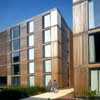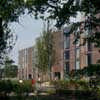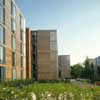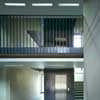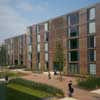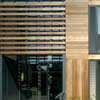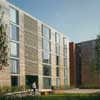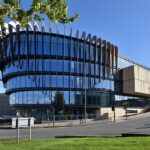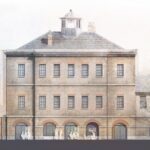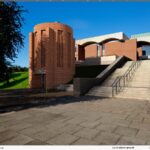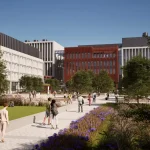Cranfield University Student Accommodation, English Academic Buildings, Architects, Photos, Project
Cranfield University Buildings, England
Contemporary Higher Education in Bedfordshire design by Stanton Williams, England, UK
26 Jun 2008
Cranfield University New Student Accommodation
Architect: Stanton Williams
Photographs © Peter Cook
Cranfield University Student Accommodation
Architectural statement
1. Concept
Cranfield University is one of Western Europe’s largest academic centres for strategic and applied research, development and design. The University originally had three campuses: Cranfield, Silsoe and Shrivenham.
As part of a rationalisation of its estate, the University proposed to relocate Silsoe activities to the Cranfield campus. The migration was to be phased over two years and required new academic and residential buildings at Cranfield to expand teaching and social facilities.
The main campus of Cranfield University is located just outside the village of Cranfield on the Bedfordshire-Buckinghamshire border, between Milton Keynes and Bedford.
The site is bounded by Duncan Road to the north and a ditch to the west and south. Existing semi-mature trees are located around the perimeter of the site.
The most interesting aspect of the site is the brook which borders the site on its western and southern sides. It brings the countryside into the site and the presence of water is expressed in the enriched tree, shrub and grassland growth.
Our proposals showed a strategy for developing the site, to provide high density accommodation on a restricted site, that allow students to engage and gain inspiration from well good quality architecture and landscape.
The key points of our proposal were:
• provision of a total of 250 student bedrooms
• high quality and well designed architecture that create a sense of place
• creation of a community and environment that instils pride
• equal emphasis on the design of social open space and that engage the senses
• integration of the new buildings with the immediate site and surrounding campus
• ease of movement and connection
• the use of sustainable, environmentally friendly design and materials
• flexibility, buildability and the ease of construction
• utilising modern, efficient and cost effective construction techniques
• internal spaces visually engage with landscape
We saw this as a challenging and stimulating opportunity, to set a new standard for student accommodation in this country.
Stanton Williams’ criteria and design aims are outlined below:
• allow students to experience high quality, inspiring architecture, engaging their senses with their environment
• enhance the mature and focussed atmosphere
• make study and leisure time productive and enjoyable
• create welcoming and user-friendly student bedrooms, flats and buildings
• furnish rooms to a high standard but also ensuring they are low maintenance, easy to clean, durable and practical
• increase student interaction
• create a physically attractive environment
• introduce shared communal landscaped spaces that bring life to the campus ‘out of academic hours’
• ensure all aspects of the accommodation and surroundings are secure and feel safe
• create an organised and practical residential layout, providing intellectual order and structure
• create visual links between internal and external spaces and allow outside views wherever possible
• Full height windows at the end of all internal corridors offer views out to the surrounding landscape
• provide sustainable and environmentally friendly architecture
• utilise modern, efficient and cost effective construction techniques
• create sensible and practical connection with the immediate site and surrounding campus
2. Block Location and Orientation
The site forms part of the campus in terms of scale and density, and our proposed layout improves the site’s relationship with Mitchell Hall compared to the previous low-density family dwellings that occupied the site. All buildings south of Duncan Road now clearly form part of the campus.
All existing buildings and residential accommodation are perpendicular to Duncan Road. Our layout follows this orientation, but contrary to the existing surrounding buildings, we have developed a new north-south pedestrian route, in order to connect the residential area north of Duncan Road with the campus.
Individual buildings are orientated so that all bedrooms are either east or west facing, allowing them to benefit from either morning or evening sun. No bedrooms are north/south facing. This is an environmentally appropriate and energy efficient orientation enabling lower heating costs and reduced solar gain.
All buildings on the site follow these rules, with the longer axis of each being parallel to Mitchell Hall and positioned around a landscaped social courtyard. Buildings are offset from one another to allow vistas between and through them, gaining views out from end elevations. A ‘village’ or ‘cluster’ of buildings is thus created.
The five new individual buildings are double-fronted; they offer active facades to either the landscaped centre space or the garden between Mitchell Hall and the proposed eastern buildings. The high proportion of glazing on each elevation, ensures all external spaces have an open relationship with the proposed and existing buildings.
The individuality of each elevation is expressed by a palette of materials relating to their orientation and with the existing buildings on the campus. Each individual block is ‘split’ along the length of the glazed internal corridors, allowing the blocks within the central space to be clad in wood forging a relationship with the external landscape. The blocks lining either Mitchell Hall or the west side of the site are treated in brick, in order to integrate with the surrounding brick buildings.
Openings on each east and west elevation are of equal proportion allowing bedrooms and communal spaces to benefit from either the morning or evening sun.
The buildings are naturally ventilated; all rooms have full height fixed glazing with openable louvred vents for ventilation, but maintaining security at ground floor level. All bedroom corridors have full height glazed openings at one end providing natural light and allowing views out. This differs from more typical student accommodation where corridors normally create ‘dead ends’.
3. Building Entrance
The entrances to each new building face the landscaped central space. Paths off the main route are created in the landscape design, guiding residents and visitors to the main entrance of the buildings.
The building entrances are celebrated by a five storey high covered external space and an external canopy, as well as double-height internal entrance spaces throwing natural daylight to the core of the buildings. The entrance halls offer strong visual connections between the east and west elevations.
Great attention has been taken to design thresholds to each block by creating raised brick planters as part of the external landscaping strategy, protecting the ground floor bedrooms from being directly overlooked by other students occupying the central space, therefore contributing to the security and privacy of the residential blocks. These brick plinths create informal seating along the edges of the gardens and offer small, private, landscaped spaces to the ground floor bedrooms.
4. Construction and materials
For the structure we used ‘Tunnel-form’. The technique utilizes a steel faced formwork system to construct concrete floors and walls in ‘tunnel’ sections. Formwork is then demounted and re-used. When a storey has been completed formwork is lifted and the process repeated on the next floor. The system has been used widely in the construction of hotels and student halls of residence with cellular, multistory layouts. The reported benefits of the system are increased speed, reduced costs and inherent fire and acoustic properties coupled to a low risk construction method.
Tunnel form will give robust internal wall finishes which will wear and last longer than plasterboard partitioning with less maintenance and repair.
Exposed thermal mass in building interiors together with controlled natural ventilation can help reduce reliance on heating and cooling systems. Tunnel-form results in more exposed concrete surfaces compared to flat slab construction and therefore increased thermal mass and potential for energy efficient building systems.
5. Landscape
The entrance to each new building faces the landscaped central space. New through routes connect this space to the academic blocks to the south of the site and the main road to the north.
We proposed in conjunction with Christopher Bradley Hole, the landscape architect, a high quality landscaped space to create a sense of identity for the new campus, encouraging students to meet, study or relax in a secured and inspiring environment, creating spaces which connect with the proportions and materials of the adjoining architecture so that the buildings and the landscape read as a complete composition.
The new landscape create a series of outside spaces which have a direct connection with the adjacent buildings on the site. To form a good link with the architecture the spaces have been designed around the same planning grid as that used for the buildings but the spaces are offset from the buildings to encourage a feeling of progression and movement.
The spaces are designed as a series of courtyards or ‘outside rooms’. Underpinning all the spaces is a plinth of brickwork which forms the path which runs through the site (the backbone) and widens to become terraces and is raised in places to form benches. It is a warm material and the layout is analogous to the foundations of buildings which emerge from the natural grassland of the site.
The central space is designed to act as a pleasant route for students from other residential part of the campus on their way to the academic facilities and establish a connection for Cranfield with the wider ‘natural’ landscape.
Cranfield University Student Accommodation info from Stanton Williams Architects
Cranfield University Landscape Strategy
Address: College Rd, Cranfield MK43 0AL
Phone: 01234 750111
Location: Cranfield University, England, UK
English Architecture
Contemporary Architecture in England
English Architecture Designs – chronological list
Curve – Leicester Theatre & Performing Arts Centre
Design: Rafael Vinoly Architects
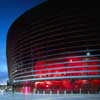
photo : Peter Cook/View
Curve Leicester
Buildings / photos for the Cranfield University Student Accommodation Architecture page welcome
Website: Cranfield University UK

